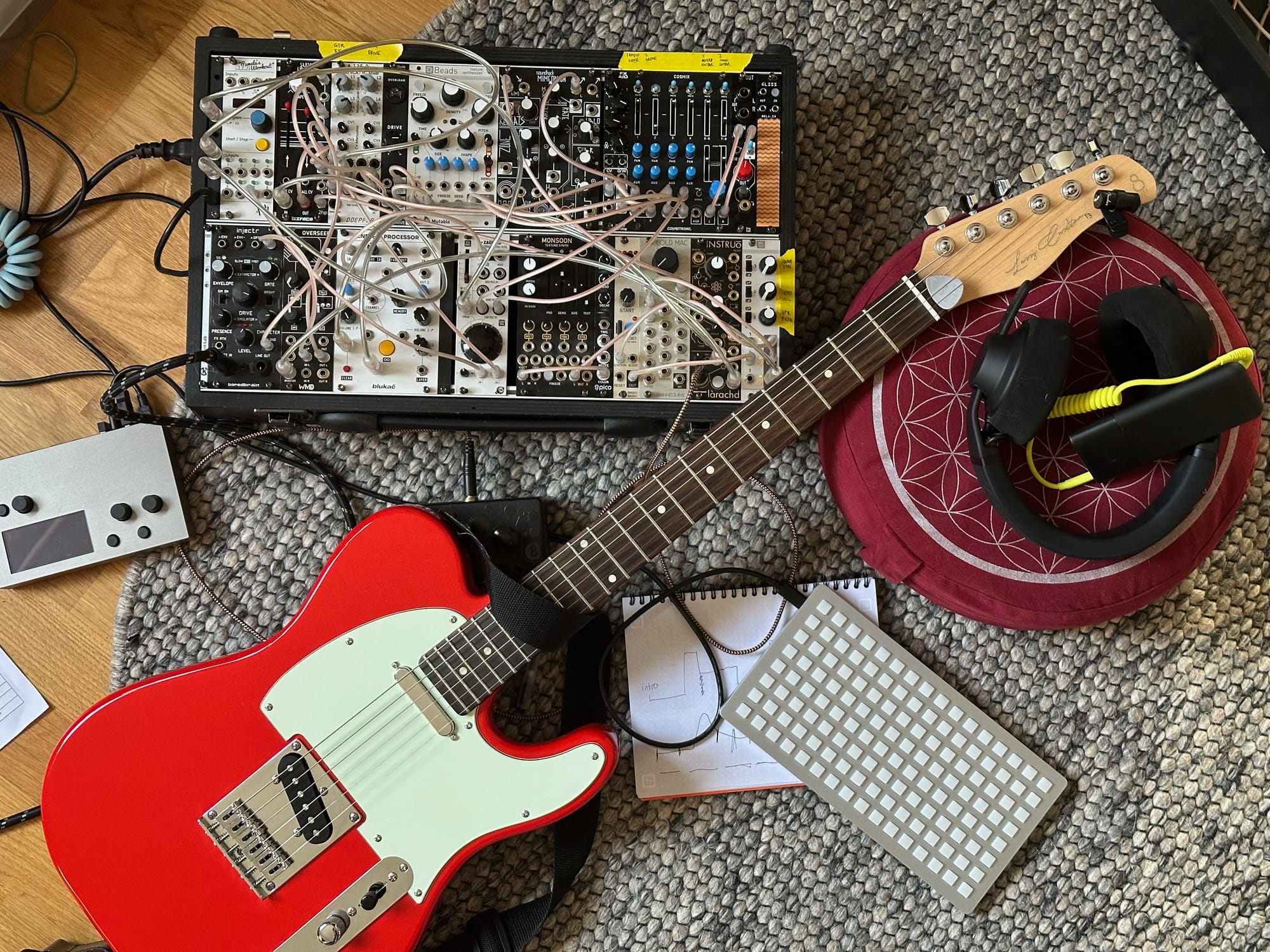Monthnotes: March 2024

Every month or so, I share a quick digest of what I've been working on and reading. Here's the latest. More in the series here.
I've been talking about putting together a live sonification show for a while, and finally I'm putting my time and money where my mouth is. A tonne of my brainspace over the last month or so has gone into developing a live performance centred around the Carrington Event - a huge solar storm that hit Earth in 1859.
For the uninitiated, a solar storm is what happens when the Sun hurls a chunk of plasma and magnetic flux into space, and that chunk hits our planet. These "coronal mass ejections" or CMEs, as they're called, happen all the time (up to three times a day, during the Sun's most active phases) and normally they just whizz out into the vast emptiness of space. But occasionally Earth gets in the way, and that's when a solar storm occurs.
Luckily, all the iron in the core of our planet gives it a magnetic field. That magnetic field deflects most of the cosmic radiation (including CMEs) that are constantly bombarding us. If it didn't, the surface of our planet would be uninhabitable. This, incidentally, is pretty much why colonising the Moon is not a good idea. The deflection process is also the cause of the aurora borealis, and the aurora australis. It's space weather. And, incidentally, I highly recommend subscribing to spaceweather.com's newsletter for a regular dispatch of what's going on in the magnetosphere.
In 1859, something pretty spectacular went on in the magnetosphere - the strongest solar storm in recorded history, known today as the Carrington Event. It gets its name from Richard Carrington, an amateur astronomer, who observed and recorded a solar flare around the start of September. About 17 hours after he spotted that flare, the Earth was hit by an enormous chunk of Sun. There was not a whole lot of electrical infrastructure back then, but the operators of telegraph equipment reported getting electric shocks, and having sparks pouring out of their machines and igniting fires. During the peaks of the storm, telegraph operators reported being able to use their equipment without them being plugged into power or connected to batteries.
Auroras were reported as far south as the Caribbean, and in the Rocky Mountains the sky was so bright that it woke gold miners who thought it was morning and started making breakfast. In Australia, one miner wrote in a letter:
"Lights of every imaginable color were issuing from the southern heavens, one color fading away only to give place to another if possible more beautiful than the last, the streams mounting to the zenith, but always becoming a rich purple when reaching there, and always curling round, leaving a clear strip of sky, which may be described as four fingers held at arm's length. The superstitious and the fanatical had dire forebodings, and thought it a foreshadowing of Armageddon and final dissolution."
Armageddon did not happen. The storm peaked twice, and then faded away, and everyone went on with their lives. But if a storm of the same power hit the Earth today, things would be different. In fact, it almost did - in 2012, a "Carrington-class" CME erupted from the Sun and hurtled through Earth's orbit. Luckily, our planet wasn't there - it had passed by just a week beforehand.
If it had been there, the extent of our dependence on modern electrical infrastructure would have meant total catastrophe. A considerably smaller event on March 13, 1989, led to the collapse of Canada’s Hydro-Quebec power grid and the loss of electricity to six million people. A 2013 study from Lloyds insurers estimated that the economic cost to the United States of a Carrington-class event today would have been between US$600 billion and $2.6 trillion. Chinese researchers estimated the recovery time from such a disaster would be four to ten years. "In my view the July 2012 storm was in all respects at least as strong as the 1859 Carrington event," Nasa researcher Daniel Baker wrote in 2014. "The only difference is, it missed."
So that's what I'm sonifying in my performance. You might think there wouldn't be much data from 1859, but you'd be wrong - quite a few observatories happened to be collecting measurements of the Earth's magnetic field at the time. In a 2014 paper, physicist Karen Aplin and meteorologist Giles Harrison digitised the records of Flagstaff Observatory in Melbourne, and when I contacted them they were willing to share that data.

My performance is built around guitar, modular synths, and a custom script that I've written for the Norns music computer. The Norns script processes the data, sending signals that control the Eurorack. The guitar also goes into the Eurorack, where it's processed by an effects chain controlled by the data. Additionally, I'm using a collection of early recordings (including one from 1860, just a year after the Carrington Event), some more modern recordings of shortwave radio, and some white noise.
At the start and end of the performance, and in the lull between the two storm peaks, the guitar comes through pretty cleanly, alongside the recordings of people chatting over the radio. But when the storm hits, the radio is eclipsed by a fuzz of noise and the guitar gets sent into a combination of delay and shimmer reverb that make it sound enormous. It hits like... well, hopefully like a massive chunk of Sun.
I'm also developing a visual component to the performance, using Touchdesigner. This tutorial, showing how to constrain a particle system to a sphere, is the basis for that -- but I need to connect that up to a part that's audio and/or data-reactive. It's a work in progress.
I'll be playing the whole thing out for the first time at a small private event in Malmö in April or May, but if all goes well I'd love to perform it elsewhere too. If you can help with that, then hit reply and let's chat!
Phew, that was a lot. So much in fact that I'll try to keep the rest of this newsletter relatively brief.
There are a couple of other work outputs I should mention. I consulted for the dataviz on this report about how advertising in public space is disproportionately located in more deprived and more polluted areas. The Guardian covered it well, including a bunch of useful summary charts.

I also worked on the dataviz for this report showing that heat pumps powered by onshore wind turbines would be a very effective way of reducing both heating bills and carbon emissions at the same time. 3,700 of the most deprived neighbourhoods in England are within 1km of an area with good onshore wind resources, so it has huge potential. If you're in Britain and think that sounds like a good idea, we have a handy tool that lets you write to your MP about it.

I'm in the finishing stages of a new Loud Numbers episode, about forest fires, which I'm hoping will be published in the coming weeks. I'll talk more about that one next time when you can actually listen to it. Oh, and I've been working on a map of sturgeon sightings (the fish), helping out a London council with some infographics, and working with a large climate funder to help analyse their grantgiving portfolio. Busy times!
That hasn't left too much capacity for input in the past month, but I have seen a few interesting things.
From-to is a neat tool that lets you map the neighbourhoods of one city onto the neighbourhoods of another. From my testing it works surprisingly well! After your first comparison, you'll need to pay $3 to unlock lifetime use, or you can just register a series of fake email addresses.

I like/am terrified by Kyle Branchesi's "The Motorist Won" series, which uses generative AI and traditional Photoshoppery techniques to illustrate what would happen if we continue to prioritise the needs of cars over the needs of humans. There's a nice interview with him about it on Designboom.

Now that it's out on Nintendo Switch, I finally got around to playing through Outer Wilds and wow - what a triumph of a game. They've done an amazing job at creating an incredibly complex puzzle system that's also incredibly rewarding to untangle. Highly recommended, as long as you can get past the tricksy controls. I'm also playing a bit of No Man's Sky on the Switch, and I'm having a good time, but it's kind of a lonely experience. Oh, and I'm watching someone play through Final Fantasy VII Rebirth on YouTube, and it's still as perfect a remake as the first instalment was. So that's nice.
OK, that's quite enough from me. I'll leave you with Finland's astonishing Eurovision entry for this year. Douze points!!





